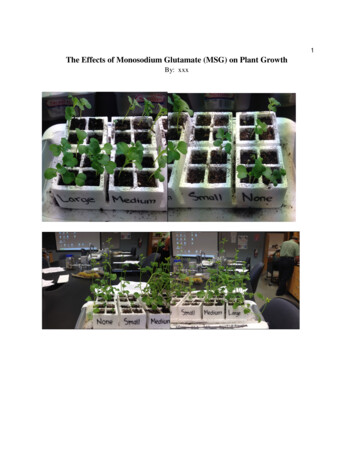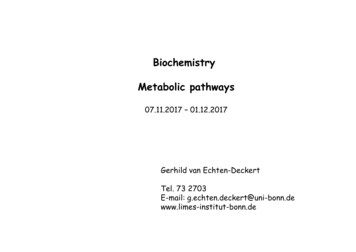
Transcription
1The Effects of Monosodium Glutamate (MSG) on Plant GrowthBy: xxx
2AbstractMonosodium glutamate (MSG) is known as an “unhealthy” ingredient in most humanfoods if present in excess, but in plants, it has actually been used in many fertilizers. Manyfarms today now spray their crops with MSG to enrich growth and to ward off insects (Fassa,par. 8). But is it really the MSG in the fertilizers making the plants grow, or is the MSG aninactive ingredient that just happens to be there? In this experiment, mustard seed plants wereplaced in soil, ranging in amounts of MSG content, so that the effects of this single compoundcould be accurately traced. There were four different plots - one containing no MSG, and theother three containing 10, 20, and 30 grains per square. After letting the plants grow in thevarious amounts of MSG-concentration, the plants were observed for health in the form ofheight, overall plot growth, and leaf length. The group with the small amount of MSG (10grains) grew significantly poor compared to the other groups, while the group with 20 grainsgrew the best. Clearly, there is a maximum point where growth is at its peak, where addingextra would actually begin to inhibit health again.IntroductionIt was hypothesized that adding MSG to the soil of the mustard plants would improvethe growth of the plants. Studies show that salts are usually detrimental to the growth of plantsbut there has been significant research demonstrating that MSG-rich fertilizers enhance plantgrowth. In a similar experiment to this one, Singh, Rekha, Arun, and Young found that “plantswere healthy and showed no signs of toxicity” when MSG was added. (2013, p. 3).
3Depending on the results of the experiment, we can determine if the MSG is helping theplants or just aiding the other ingredients in the fertilizer. This experiment had isolated MSG asan individual compound and independent variable in order to learn and understand its effects onthe mustard plants and accurately research them.Methods and MaterialsMaterials:-plastic container with a specialized pre-cut lid-32 wickes-styrofoam tray with 8 quads (32 compartments)-fertilizer pellets-soil-algae prevention squares-large absorption strip-64 seeds-pipettes-beaker of deionized water-lamp-Monosodium glutamate
4Methods:During the first week of the experiment, soil was placed into the 32 styrofoamcompartments with two seeds, one fertilizer pellet, and one wicke per compartment. The wickswere utilized to absorb water from the large absorption strip that was half immersed in waterand the other half placed under the styrofoam compartments. The styrofoam tray was placed ontop of the empty plastic container with its lid closed. The four plots (each with eightcompartments) were labeled with the amounts of MSG (none, small, medium, large). Each ofthese four plots were given different amounts of MSG:None - 0 grains MSG (to serve as control)Small - 10 grains MSGMedium - 20 grains MSGLarge - 30 grains MSGFor the first few days, each compartment was watered by hand with pipettes (to allowMSG to properly dissolve), then the container was filled halfway with water at the beginning ofweek two, allowing the absorption strip to provide the plants with a moderate amount of water.The plants were hand watered every Monday, Wednesday, and Friday, due to the drynesscaused by the lamp. Measurements of the plants took place only on Wednesdays and Fridays. Ifone of the compartment’s soil was observed to be dry then watering by hand was essential. Themeasurements taken were of the smallest plant (excluding the compartments of no growth) andof the tallest plant. At the end for comparison, leaf length measurements and “no growth”compartments were used to indicate health, as well. For the third week, only observation andmeasurement were necessary.
5ResultsFigure 1.1How different amounts of MSG correlate to plant height and leaf lengthEach amount of MSG produced different plant heights. Looking at both the shortestplant and largest plant in each plot, one can clearly see that the medium amount of MSG (20grains) produced the tallest plants overall. These plants grew taller than the plots with both lessand more MSG. The second tallest plot was the constant. This graph also measured leaf length,and this correlated with the lines regarding plant height. Once again, the medium amountproduced the longest leaves.
6Figure 1.2How varying amounts of MSG impacted overall plot growth (how many plants grew out of theeight in each plot)?DiscussionOur results proved that a medium amount of MSG (20 grains) resulted in the healthiestplant growth. A medium amount of MSG actually produced healthier plants than a largeamount of it, indicating that there is a peak point where adding more MSG is counterproductive.The “healthiness” of the plants was measured by plant height, leaf length, and the total amountof growth (or lack of growth) in each plot. All three categories follfollowedowed a similar pattern,starting fairly high with the control, dipping very low with a small amount of MSG, peaking at amedium amount of MSG, and starting to go back down at a high level of MSG. The mediumamount of MSG produced the tallest plants with ththee longest leaves, with 100% growth shown inthe plot. Using this data, it was concluded that this amount had created the healthiest plants.
7Before the experiment was performed, it was questioned whether or not MSG was evenan effective ingredient to the MSG fertilizers often used by farmers. By looking at the results ofthis experiment, it proves that the medium amounts of MSG were beneficial, and that it is likelyMSG contributes to the quality of growth in crops.Compared to the experiment performed by Singh and the other ecological scientists,these results were accurate. In their experiment, plants growing in MSG-contaminated waterhad higher germination rates (Singh et al (2008). In another experiment, by Richmond Tan, partof a home garden was treated with MSG, while some parts of the garden were not, and theMSG-treated plants had more successful growth. Once again, MSG resulted in greater growth.The results of these two outside experiments fit with this experiments results, but also varieddue to the fact that one was no laboratory based, and observations were not precise, and theother tested MSG in polluted water, rather than in pure soil.
8ConclusionAs a result of this experiment, the hypothesis declared was proven to be true andconfirmed that MSG aids plant growth. It also demonstrated how a fair amount of MSG wasbeneficial in plant growth and should be used more in fertilizers. A small or large amount ofMSG added to plants are not as beneficial for growth according to the results received becausethe plot with small amount did not grow and large amount did not grow as well. In addition, theusing of cloth and wicks to water of the plants was found to be less effective than hand wateringthe plants, as the wicks did not carry water as efficiently as they should have. As Anotherimprovement to this experiment might include growing additional plants, to provide furtheraccuracy to the results. Overall though, this experiment was an efficient way to better learn andunderstand the effects of varying amounts of MSG in supporting plant growth.
9Works CitedTan, Richmond. "A Fertilizer Experiment." Web log post. Dream N Grow It. N.p., 10 Feb.2010. Web. 14 Oct. 2013. rtilizer-experiment/ Singh, Satnam, P.D. Rekha, A.B. Arun, and Chiu-Chung Young. Impacts of MonosodiumGlutamate Industrial Wastewater on Plant Growth And soil Characteristics.Ecological Engineering. N.p., 18 Dec. 2008. Web. 14 Oct. 2013.Fassa, Paul. "MSG Now Used to Spray Crops." Natural News. N.p., 29 Apr. 2009. Web. 15Sept. 2013. http://webcache.googleusercontent.com/search?q n/215609264 Impacts of monosodium glutamate industrial wastewater on plantgrowth and soil characteristics/file/9fcfd505a73103a4a0.pdf &cd 3&hl en&ct clnk&gl us
foods if present in excess, but in plants, it has actually been used in many fertilizers. Many . (20 grains) resulted in the healthiest plant growth. A medium amount of MSG actually produced healthier plants than a large . with 100% growth shown in 6 . 7 Before the experiment was performed, it was questioned whether or not MSG was even .










